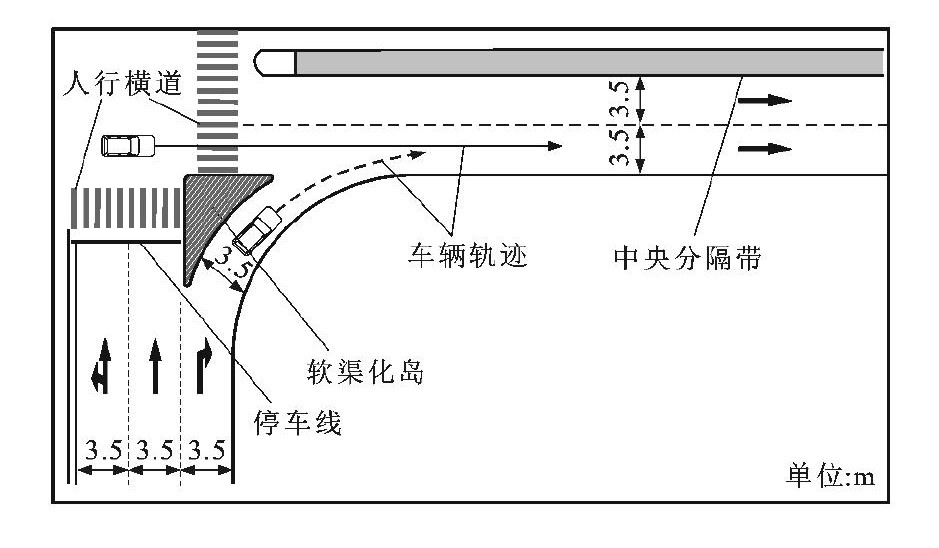Design approach of channelized island based on traffic conflict models at signalized intersection
-
摘要: 为了优化信号交叉口渠化岛, 提出了一种基于交通冲突模型的信号交叉口渠化岛设置方法; 提取了昆明市20个信号交叉口交通冲突数据、交通流数据、交通控制方式数据和几何设计数据, 采用贝叶斯方法, 构建了贝叶斯固定参数交通冲突模型和贝叶斯随机参数交通冲突模型, 分析了模型的拟合优度和显著影响因素; 基于随机参数交通冲突模型, 确定了期望交通冲突数计算公式; 绘制了信号交叉口渠化岛设置标准曲线, 给出了信号交叉口渠化岛类型选择流程。分析结果表明: 随机参数交通冲突模型比固定参数交通冲突模型拟合结果更好; 交通量(直行交通量和右转交通量)、渠化岛类型与右转设计要素(右转让行标志和右转半径) 变量系数服从正态分布; 每增加1%的直行交通量, 交通冲突增加0.56%;每增加1%的右转交通量, 交通冲突增加0.53%;4种类型渠化岛的设置可以使交通冲突分别降低12.75%、23.37%、16.18%、33.64%;右转让行标志可使交通冲突降低15.03%;右转半径增加1%, 直右交通冲突降低1.72%。可见, 基于交通冲突模型的渠化岛设置方法是可行的。Abstract: In order to optimize the channelized island design at signalized intersection, a design approach of channelized island based on traffic conflict models was proposed. Traffic conflict data, traffic flow data, traffic control data, and geometric design data were collected at twenty signalized intersections in Kunming. Adopting Bayesian method, Bayesian fix parameter traffic conflict model and Bayesian random parameter traffic conflict model were constructed. The fitting goodnesses and significant influencing factors of the models were analyzed. Based on the random parameter traffic conflict model, the formula of calculating the expected number of traffic conflicts was determined. The design standard curves of channelized islands at signalized intersections were drawn, and the type selection procedure of channelized islands was proposed. Analysis result shows that the random parameter traffic conflict model yields better fitting result than the fixed parameter model. The variable coefficients of traffic volumes (crossing through traffic volume and right-turn traffic volume), channelized island types, and right-turn design elements (right-turn yielding sign and right-turn radius) obey normal distributions. When the crossing through traffic volume increases by 1%, the traffic conflict frequency increases by 0.56%. When the right-turn traffic volume increases by 1%, the traffic conflict frequency increases by 0.53%. The four types of channelized islands can reduce the traffic conflict frequency by 12.75%, 23.37%, 16.18% and 33.64%, respectively. The right-turn yielding sign can reduce the traffic conflict by 15.03%. When the right-turn radius increases by 1%, the right-turn traffic conflict frequency reduces by 1.72%. The research conclusion indicates that the design approach of channelized islands based on the traffic conflict models is feasible.
-
表 1 分类自变量
Table 1. Category independent variables

表 2 连续自变量
Table 2. Continuous independent variables

表 3 交通冲突模型标定结果
Table 3. Calibration result of traffic conflict models

-
[1] 《中国公路学报》编辑部. 中国交通工程学术研究综述[J]. 中国公路学报, 2016, 29 (6): 1-161. doi: 10.3969/j.issn.1001-7372.2016.06.001Editorial Department of China Journal of Highway and Transport. Review on China's traffic engineering research progress[J]. China Journal of Highway and Transport, 2016, 29 (6): 1-161. (in Chinese). doi: 10.3969/j.issn.1001-7372.2016.06.001 [2] GUO Yan-yong, LIU Pan, BAI Lu, et al. Red light running behavior of electric bicycles at signalized intersections in China[J]. Transportation Research Record, 2014 (2468): 28-37. [3] 赵靖, 付晶燕, 杨晓光. 信号控制交叉口动态车道功能优化方法[J]. 同济大学学报: 自然科学版, 2013, 41 (7): 996-1001. doi: 10.3969/j.issn.0253-374x.2013.07.006ZHAO Jing, FU Jing-yan, YANG Xiao-guang. Optimization model of dynamic lane assignment for isolated signalized intersections[J]. Journal of Tongji University: Natural Science, 2013, 41 (7): 996-1001. (in Chinese). doi: 10.3969/j.issn.0253-374x.2013.07.006 [4] AUTEY J, SAYED T, ZAKI M H. Safety evaluation of rightturn smart channels using automated traffic conflict analysis[J]. Accident Analysis and Prevention, 2012, 45: 120-130. doi: 10.1016/j.aap.2011.11.015 [5] MENG Qiang, QU Xiao-bo. Estimation of rear-end vehicle crash frequencies in urban road tunnels[J]. Accident Analysis and Prevention, 2012, 48: 254-263. doi: 10.1016/j.aap.2012.01.025 [6] GB 50674—2011, 城市道路交叉口规划规范[S].GB 50674—2011, code for planning of intersections on urban roads[S]. (in Chinese). [7] CJJ 152—2010, 城市道路交叉口设计规程[S].CJJ 152—2010, specification for design of intersection on urban roads[S]. (in Chinese). [8] AL-KAISY A, ROEFARO S. Channelized right-turn lanes at signalized intersections: a review of practice[C]//TRB. Proceedings of the Fourth International Symposium on Highway Geometric Design. Washington DC: Transportation Research Board, 2010: 2-5. [9] 杨静, 史玉茜, 杨晓光. 典型信号交叉口右转渠化岛设计模式的适用性研究[J]. 交通与运输: 学术版, 2011, 27 (12): 124-128. https://www.cnki.com.cn/Article/CJFDTOTAL-JTYH201102034.htmYANG Jing, SHI Yu-qian, YANG Xiao-guang. Research on the application for right turn channeling island design patterns in signalized intersections[J]. Traffic and Transportation: Academic Version, 2011, 27 (12): 124-128. (in Chinese). https://www.cnki.com.cn/Article/CJFDTOTAL-JTYH201102034.htm [10] 梁潇. 信号交叉口渠化区可变车道设计原理研究[D]. 长春: 吉林大学, 2008.LIANG Xiao. Research on signal intersection channeling area variable lane design theorem[D]. Changchun: Jilin University, 2008. (in Chinese). [11] DIXON K K, HIBBARD J L, NYMAN H. Right-turn treatment for signalized intersections[C]//TRB. 1999 Proceedings of Transportation Research Circular E-C019: Urban Street Symposium. Washington DC: Transportation Research Board, 1999: 1-11. [12] 韩印, 邢冰, 姚佼, 等. 混合交通流条件下区域交通信号控制优化模型[J]. 交通运输工程学报, 2015, 15 (1): 119-126. doi: 10.3969/j.issn.1671-1637.2015.01.016HAN Yin, XING Bing, YAO Jiao, et al. Optimal model of regional traffic signal control under mixed traffic condition[J]. Journal of Traffic and Transportation Engineering, 2015, 15 (1): 119-126. (in Chinese). doi: 10.3969/j.issn.1671-1637.2015.01.016 [13] 吴瑶. 平面信号交叉口优化设计与效果评价研究[D]. 西安: 长安大学, 2013.WU Yao. Study on optimization and evaluation of signalized intersection[D]. Xi'an: Chang'an University, 2013. (in Chinese). [14] SAYED T, ZEIN S. Traffic conflict standards for intersections[J]. Transportation Planning and Technology, 1999, 22 (4): 309-323. doi: 10.1080/03081069908717634 [15] EI-BASYOUNY K, SAYED T. Safety performance functions using traffic conflicts[J]. Safety Science, 2013, 51 (1): 160-164. doi: 10.1016/j.ssci.2012.04.015 [16] SACCHI E, SAYED T. Bayesian estimation of conflict-based safety performance functions[J]. Journal of Transportation Safety and Security, 2016, 8 (3): 266-279. doi: 10.1080/19439962.2015.1030807 [17] ZHANG Xin, LIU Pan, CHEN Yu-guang, et al. Modeling the frequency of opposing left-turn conflicts at signalized intersections using generalized linear regression models[J]. Traffic Injury Prevention, 2014, 15 (6): 645-651. doi: 10.1080/15389588.2013.860526 [18] 郭延永, 刘攀, 徐铖铖, 等. 基于交通冲突模型的信号交叉口右转设施安全分析[J]. 中国公路学报, 2016, 29 (11): 139-146. https://www.cnki.com.cn/Article/CJFDTOTAL-ZGGL201611020.htmGUO Yan-yong, LIU Pan, XU Cheng-cheng, et al, Safety analysis of right-turn facility at signalized intersection using traffic conflict model[J]. China Journal of Highway and Transport, 2016, 29 (11): 139-146. (in Chinese). https://www.cnki.com.cn/Article/CJFDTOTAL-ZGGL201611020.htm [19] HAYWARD J C. Near-miss determination through use of a scale of danger[J]. Highway Research Record, 1972, 384 (1): 24-34. [20] GUO Yan-yong, SAYED T, ZAKI M H. Automated analysis of pedestrian walking behaviour at a signalised intersection in China[J]. IET Intelligent Transport Systems, 2016, 11 (1): 28-36. [21] CHIN H C, QUEK S T. Measurement of traffic conflict[J]. Safety Science, 1997, 26 (3): 169-185. [22] GUO Yan-yong, SAYED T, ZAKI M H, et al. Safety evaluation of unconventional outside left-turn lane using automated traffic conflict techniques[J]. Canadian Journal of Civil Engineering, 2016, 43 (7): 631-642. [23] ANASTASOPOULOS P C, MANNERING F L. A note on modeling vehicle accident frequencies with random-parameters count models[J]. Accident Analysis and Prevention, 2009, 41 (1): 153-159. [24] GUO Yan-yong, LIU Pan, LIANG Qi-yu, et al. Effects of parallelogram-shaped pavement markings on vehicle speed and safety of pedestrian crosswalks on urban roads in China[J]. Accident Analysis and Prevention, 2016, 95: 438-447. [25] SPEIGELHALTER D J, BEST N G, GARLIN B P, et al. Bayesian measures of model complexity and fit[J]. Journal of the Royal Statistical Society Series B, 2003, 64 (4): 583. -





 下载:
下载:









